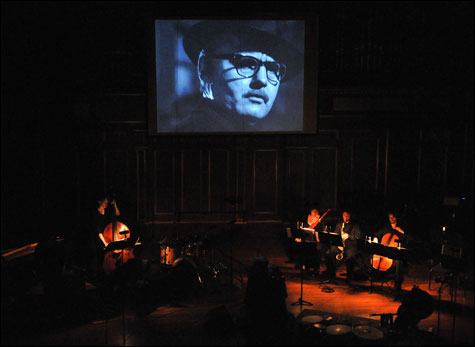
PLENTY The Ran Blake/NEC Pawnbroker concert was exasperating but also indelibly brilliant. |
Film noir has been a running theme in composer/pianist Ran Blake's work since the beginning of his career — his very first album, TheNewest Sound Around (RCA, 1962), with singer Jeanne Lee, began with David Raskin's theme to Otto Preminger's Laura. Blake has played improvisations based on the work of soundtrack composers, or composed wholly new pieces based on films that he loves. On occasion, he's performed with a favorite scene from a movie projected silently on a screen behind him.
At New England Conservatory — where he has been a teacher since 1968 — on November 9, Blake and NEC's Third Stream–Contemporary Improvisation Department presented Sidney Lumet's 1964 film The Pawnbroker. If you've attended one of these annual Blake-NEC cinema-music mash-ups before, you know that this wasn't standard "live soundtrack" accompaniment. Here, The Pawnbroker (from Edward Lewis Wallant's 1961 novel) was a hybrid film screening, student-faculty recital, and illustrated lecture. Instead of the usual Halloween noir date, this year's concert was scheduled for November 9, the anniversary of Kristallnacht, the 1938 pogrom in Germany that marks the unofficial beginning of the Holocaust. So The Pawnbroker — with Rod Steiger as Sol Nazerman, a Jewish concentration-camp survivor living in New York — was also billed as a memorial.
There was a lot that was frustrating about the event, much of it endemic to recitals of this kind, where broad student participation is encouraged and — as we used to say in school — all the kids should get a chance to play. There were at least six different ensembles, from unaccompanied piano and percussion solos to a big band, so there were set changes between nearly all 24 "scenes." Those scenes — in a sharp DVD transfer of Boris Kaufman's rich black-and-white cinematography — were played on a screen over the stage. Much of the time, they ran silently, with subtitles, while live musicians played. Or the soundtrack faded in and out, so that the dialogue and Quincy Jones's recorded score alternated with the live music. At times, it was as if one were watching a silent film with old-fashioned "title cards" and live music. But there were at least a couple of times when the live music and the soundtrack clashed, and at one point a singer had to compete with spoken dialogue. Perhaps most annoying were the several interruptions for spoken-word commentaries on film versus novels versus music. The event ran three hours with intermission.
That said, this was a riveting evening of music. It was fleshed out with faculty ringers, true, but I'd be eager to hear any of these students play again — or any of these pieces. The concert began with the film's opening scene: Steiger, bespectacled, lumpy, and dour, closing up shop with an assistant. Then, lights down, violinist Mia Friedman and cellist Ari Friedman elaborated on the minor-keyed Yom Kippur lament "Kol Nidre," their overlapping phrases a continuous line of sighs and effusions. Following a spoken introduction, Ken Schaphorst led a big band in his arrangement of the Quincy Jones jazz theme over the daylight title sequence of Nazerman driving through Harlem.